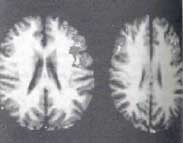Finesse is female
 MEN and women not only think differently -- as Mary Wollestonecraft first said last century -- but also use different parts of their brain to do the same thing, says a group of American researchers.
MEN and women not only think differently -- as Mary Wollestonecraft first said last century -- but also use different parts of their brain to do the same thing, says a group of American researchers.
Bennit A Shywitz of the Department of Neurology, Yale University School of Medicine, Connecticut, and his colleagues, scanned the brain of volunteers as they performed a variety of tasks to track where specific language-tasks rested in the brain, that could give insights into reading disabilities. The objective was also to provide direct evidence of differential engagement of the left hemisphere of the brain in language-related tasks, among normal male and female volunteers. (Science vol 373 no 6515). They used recent advances in functional neuro-imaging, which permit small changes in the blood flow in the brain to be localised with magnetic resonance imaging.
The Yale University team found new evidence of gender differences in the human brain which bolsters the idea that it concentrates language-related jobs on its left side much more in men than in women. "We have demonstrated remarkable differences in functional organisation of a specific component of language and phonological processing between males and females," says Shywitz.
Researchers from the University of Pennsylvania used positron emission tomography (PET) -- the latest in hi-tech imaging -- to look at the variations in the brain metabolism of 37 men and 24 women. Volunteers lay down in a darkened room, with their eyes open and heads inside a complex apparatus, and were asked to do and think nothing. Researchers injected glucose with a radioactive tracer into an artery leading to the brain. Areas metabolising the most glucose glowed brightest on the screen. The idea was to compare the magnetic resonance images, since they give detailed pictures of the different parts of the brain and their metabolism of glucose, to see how the different components of the brain function.
The findings reveal that in both men and women, the brain has nearly identical patterns of activity, except in that portion which controls emotional responses. The male brain was more active in the temporal limbic system (a structure concerned with physical action), while in women it was more active in the cingulate gyrus (a structure thought to govern gestures and communication). This explains why men tend to be physically more aggressive, while women are more inclined, biologically, to be refined with symbolic means of emotional expression.
However, Rakesh Parikh, neuropsychiatrist at Bombay's Jaslok Hospital, says that these findings are quite limited, since they refer to the resting brain. There is still no information on how men and women perform various tasks. "Still, this is the first time we have actually documented sex differences in brain functioning," he admits.
